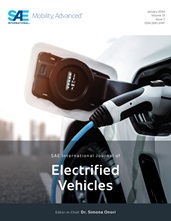Recovering solar energy during parking phases can significantly improve
light-duty vehicles’ fuel economy (FE) and help in reducing greenhouse gas
impact and harmful tailpipe emissions. Nevertheless, the contribution due to
off-driving photovoltaic (PV) recharging shall be adequately accounted for when
approaching the development and testing of energy-efficient and
environment-friendly powertrain energy management. The aim of this work was thus
to enhance the existing highly charge-depleting (HCD) control strategy of a 48V
mild-hybrid electric vehicle (MHEV), implementing a state-of-charge-dependent
soft charge-depleting (SCD) one.
The performance of the implemented control strategy was analyzed on two different
vehicle configurations, obtained by integrating a solar kit with the
aforementioned mild-hybrid powertrain. The modelling framework used to perform
simulation-based analysis was suitably updated in such a way as to test both
charge-depleting and quasi-charge-sustaining strategies. A scenario analysis was
thus enabled, whose objective was to assess the FE and carbon dioxide
(CO2) reduction potential associated with the joint effect of
solar hybridization and the proposed battery state-of-charge-driven control
rules. The Federal Urban Driving Schedule (FUDS) was simulated for the four
vehicle scenarios available (conventional, MHEV-HCD, MHEV-SCD, and solar mild
hybrid). The results confirmed the high potential of solar-assisted
mild-hybridization of original conventional vehicles, with significant benefits
(i.e., about 30% improvement) achieved both in terms of FE and CO2
emissions.
